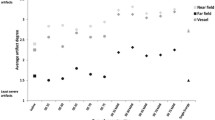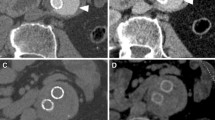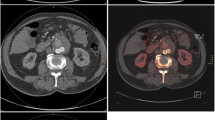Abstract
Purpose
To evaluate the usefulness of the advanced monoenergetic imaging (AMI) reconstruction technique for dual-energy computed tomography to evaluate endoleaks after endovascular stent-graft placement.
Materials and methods
Ninety-five dual-phase (early and delayed phases) enhanced CT examinations were performed for 60 patients who underwent endovascular stent-graft placement. AM images were reconstructed at 40 keV and compared with the standard 120-kVp images (SI). The signal-to-noise ratio (SNR) and contrast-to-noise ratio (CNR) of the aorta and endoleak were measured. Two radiologists subjectively assessed endoleak delineation and contrast enhancement conditions using a 5-point Likert scale (1: poor—5: excellent).
Results
Mean SNRs of the aorta were higher by AMI (early; 34.7 ± 10.2 [SD], delay; 11.4 ± 3.2) than by SI (early; 23.1 ± 6.3, delay; 8.6 ± 2.2) (P < 0.001). SNRs of the endoleak were higher by AMI (early; 26.3 ± 7.5, delay; 10.5 ± 3.1) than by SI (early; 18.2 ± 4.7, delay; 8.3 ± 2.1) (P < 0.001). CNRs by AMI (early; 32.9 ± 9.8, delay; 8.9 ± 2.8) were higher than those by SI (early; 19.5 ± 6.0, delay; 4.7 ± 1.6) in both phases (P < 0.001). Endoleak delineation and contrast enhancement conditions by AMI (4.4 ± 1.0 and 4.5 ± 0.6) were higher than those by SI (3.4 ± 1.0 and 3.3 ± 0.8) in the delayed phase (P < 0.001). There was no difference in the early phase.
Conclusion
AMI may be useful for evaluating endoleaks after endovascular stent-graft placement.





Similar content being viewed by others
References
Stavropoulos SW, Charagundla SR (2007) Imaging techniques for detection and management of endoleaks after endovascular aortic aneurysm repair. Radiology 243:641-55.
Petrik PV, Moore WS (2001) Endoleaks following endovascular repair of abdominal aortic aneurysm: the predictive value of preoperative anatomic factors--a review of 100 cases. J Vasc Surg 33:739-44.
Arko FR, Rubin GD, Johnson BL, Hill BB, Fogarty TJ, Zarins CK (2001) Type-II endoleaks following endovascular AAA repair: preoperative predictors and long-term effects. J Endovasc Ther 8:503-10.
Stolzmann P, Frauenfelder T, Pfammatter T, Peter N, Scheffel H, Lachat M, et al. (2008) Endoleaks after endovascular abdominal aortic aneurysm repair: detection with dual-energy dual-source CT. Radiology 249:682-91.
Rozenblit AM, Patlas M, Rosenbaum AT, Okhi T, Veith FJ, Laks MP, et al. (2003) Detection of endoleaks after endovascular repair of abdominal aortic aneurysm: value of unenhanced and delayed helical CT acquisitions. Radiology 227:426-33.
Yu L, Leng S, McCollough CH (2012) Dual-energy CT-based monochromatic imaging. AJR Am J Roentgenol 199:S9-S15.
Apfaltrer P, Sudarski S, Schneider D, Nance JW Jr, Haubenreisser H, Fink C, et al. (2014) Value of monoenergetic low-kV dual energy CT datasets for improved image quality of CT pulmonary angiography. Eur J Radiol 83:322-8.
Albrecht MH, Scholtz JE, Hüsers K, Beeres M, Bucher AM, Kaup M, et al. (2016) Advanced image-based virtual monoenergetic dual-energy CT angiography of the abdomen: optimization of kiloelectron volt settings to improve image contrast. Eur Radiol 26:1863-70.
Albrecht MH, Trommer J, Wichmann JL, Scholtz JE, Martin SS, Lehnert T, et al. (2016) Comprehensive comparison of virtual monoenergetic and linearly blended reconstruction techniques in third-generation dual-source dual-energy computed tomography angiography of the thorax and abdomen. Invest Radiol 51:582-90.
Beeres M, Trommer J, Frellesen C, Nour-Eldin NE, Scholtz JE, Herrmann E, et al. (2016) Evaluation of different keV-settings in dual-energy CT angiography of the aorta using advanced image-based virtual monoenergetic imaging. Int J Cardiovasc Imaging 32:137-44.
Martin SS, Wichmann JL, Weyer H, Scholtz JE, Leithner D, Spandorfer A, et al. (2017) Endoleaks after endovascular aortic aneurysm repair: Improved detection with noise-optimized virtual monoenergetic dual-energy CT. Eur J Radiol 94:125-32.
Koike Y, Nishimura J, Hase S, Yamasaki M (2015) Sac angiography and glue embolization in emergency endovascular aneurysm repair for ruptured abdominal aortic aneurysm. Cardiovasc Intervent Radiol 38:457-62.
McDonald JS, McDonald RJ, Comin J, Williamson EE, Katzberg RW, Murad MH, et al. (2013) Frequency of acute kidney injury following intravenous contrast medium administration: a systematic review and meta-analysis. Radiology 267:119-28.
Nyman U, Almén T, Aspelin P, Hellström M, Kristiansson M, Sterner G (2005) Contrast-medium-Induced nephropathy correlated to the ratio between dose in gram iodine and estimated GFR in ml/min. Acta Radiol 46:830-42.
Walsh SR, Tang TY, Boyle JR (2008) Renal consequences of endovascular abdominal aortic aneurysm repair. J Endovasc Ther 15:73-82.
Delesalle MA, Pontana F, Duhamel A, Faivre JB, Flohr T, Tacelli N, et al. (2013) Spectral optimization of chest CT angiography with reduced iodine load: experience in 80 patients evaluated with dual-source, dual-energy CT. Radiology 267:256-66.
Raju R, Thompson AG, Lee K, Precious B, Yang TH, Berger A, et al. (2014) Reduced iodine load with CT coronary angiography using dual-energy imaging: a prospective randomized trial compared with standard coronary CT angiography. J Cardiovasc Comput Tomogr 8:282-8.
Shuman WP, Chan KT, Busey JM, Mitsumori LM, Koprowicz KM (2016) Dual-energy CT aortography with 50% reduced iodine dose versus single-energy CT aortography with standard iodine dose. Acad Radiol 23:611-8.
Author information
Authors and Affiliations
Corresponding author
Ethics declarations
Conflict of interest
We do not have any conflicts of interest and financial disclosures or acknowledgments.
Additional information
Publisher's Note
Springer Nature remains neutral with regard to jurisdictional claims in published maps and institutional affiliations.
Rights and permissions
About this article
Cite this article
Sawada, Y., Shimohira, M., Nakagawa, M. et al. Advanced monoenergetic reconstruction technique for dual-energy computed tomography to evaluate endoleaks after endovascular stent-graft placement. Abdom Radiol 45, 2569–2575 (2020). https://doi.org/10.1007/s00261-020-02602-7
Published:
Issue Date:
DOI: https://doi.org/10.1007/s00261-020-02602-7




